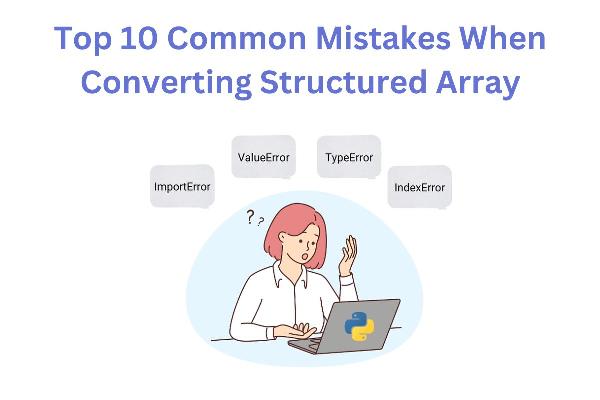Top 10 Common Mistakes When Converting Structured Array

Strong 8k brings an ultra-HD IPTV experience to your living room and your pocket.
Introduction on Structured Arrays
Structured arrays are an essential tool in programming, allowing us to handle complex datasets efficiently by organizing data into meaningful structures. They are particularly useful in scientific computing, data analysis, and various other fields where handling multi-dimensional data is necessary. However, converting structured arrays from one format to another can be challenging and error-prone. Many programmers, both beginners and experienced, often encounter issues that can lead to data corruption, inefficiencies, and unexpected behavior.
Top 10 common mistakes to avoid when converting structured arrays
1. Ignoring Data Types
Mistake: Not paying attention to data types during conversion.
Explanation: Structured arrays often contain multiple data types (integers, floats, strings, etc.). Ignoring these can lead to data corruption or loss.
Tip: Always ensure that the target structure matches the data types of the source array. Use functions that maintain or correctly convert data types.
2. Mismatched Field Names
Mistake: Field names in the source and target arrays don’t match.
Explanation: Structured arrays use field names to access data. Mismatched names can cause errors or incorrect data mapping.
Tip: Double-check that the field names in both the source and target arrays match exactly, including case sensitivity.
3. Inconsistent Array Shapes
Mistake: Trying to convert arrays of different shapes without proper handling.
Explanation: Arrays need to be reshaped appropriately to ensure data consistency.
Tip: Ensure both arrays have the same shape or handle reshaping carefully. Use functions like reshape() in NumPy to manage array shapes properly.
4. Overlooking Memory Layout
Mistake: Not considering the memory layout (C-order vs. Fortran-order).
Explanation: Memory layout affects how data is stored and accessed. Ignoring this can lead to performance issues or incorrect data interpretation.
Tip: Specify the desired memory layout when creating or converting arrays using parameters like order='C' or order='F'.
5. Improper Use of Views vs. Copies
Mistake: Confusing views with copies when converting arrays.
Explanation: Views are references to the original data, while copies are independent. Using views when a copy is needed (or vice versa) can lead to unintended modifications or memory overhead.
Tip: Use copy() to explicitly create a copy if needed, and be aware of when you are working with a view versus a copy.
6. Neglecting Endianness
Mistake: Not accounting for endianness (byte order) in data conversion.
Explanation: Endianness affects how bytes are ordered within data types. Ignoring it can lead to incorrect data interpretation, especially when sharing data between different systems.
Tip: Use functions like newbyteorder() in NumPy to adjust the byte order if necessary.
7. Inadequate Error Handling
Mistake: Failing to implement proper error handling during conversion.
Explanation: Conversions can fail due to various reasons (e.g., incompatible data types, shape mismatches). Not handling these errors can lead to crashes or undefined behavior.
Tip: Implement robust error handling using try-except blocks and check for potential issues before performing conversions.
8. Ignoring Data Alignment
Mistake: Not considering data alignment requirements.
Explanation: Misaligned data can lead to inefficient memory access and performance degradation.
Tip: Ensure that data is aligned properly, especially when working with low-level operations or interfacing with hardware.
9. Forgetting to Update Metadata
Mistake: Not updating associated metadata after conversion.
Explanation: Structured arrays often come with metadata (e.g., descriptions, units). Failing to update this can lead to confusion and errors down the line.
Tip: Always update metadata to reflect changes made during the conversion process.
10. Not Testing Thoroughly
Mistake: Skipping thorough testing after conversion.
Explanation: Even minor changes in data structure can have significant impacts. Not testing thoroughly can result in undetected bugs.
Tip: Test the converted arrays comprehensively to ensure that all data is correctly mapped and accessible. Use unit tests to cover various scenarios and edge cases.
Conclusion
Converting structured arrays requires careful attention to detail to avoid common pitfalls. By being aware of these top 10 mistakes and following the tips provided, you can ensure a smooth and accurate conversion process. Remember to pay attention to data types, field names, array shapes, memory layout, and other critical factors. Implementing robust error handling, maintaining data alignment, updating metadata, and thoroughly testing the converted arrays will help you achieve reliable and efficient conversions. To gain deeper knowledge and hands-on experience, Consider Exploring in an Offline or Online Data Science course in Indore, Delhi, Ghaziabad, and other nearby cities in India.
FAQs on Top 10 Common Mistakes to Avoid When Converting Structured Arrays
1. What are structured arrays?
Structured arrays are arrays with a defined structure that allows for the storage of complex data types. They are commonly used in scientific computing and data analysis to organize and manage multi-dimensional data efficiently.
2. Why is it important to pay attention to data types during conversion?
Ignoring data types during conversion can lead to data corruption or loss. Ensuring that the target structure matches the data types of the source array helps maintain data integrity and prevents unexpected errors.
3. How can mismatched field names affect the conversion process?
Field names are used to access data in structured arrays. If the field names in the source and target arrays do not match, it can cause errors or incorrect data mapping, leading to data being placed in the wrong fields.
4. What should I do if the source and target arrays have different shapes?
If the source and target arrays have different shapes, you need to handle reshaping carefully to ensure data consistency. Use functions like reshape() in NumPy to manage array shapes appropriately.
5. How does memory layout affect structured array conversion?
Memory layout (C-order vs. Fortran-order) affects how data is stored and accessed. Ignoring memory layout can lead to performance issues or incorrect data interpretation. Specify the desired memory layout using parameters like order='C' or order='F'.
Note: IndiBlogHub features both user-submitted and editorial content. We do not verify third-party contributions. Read our Disclaimer and Privacy Policyfor details.


